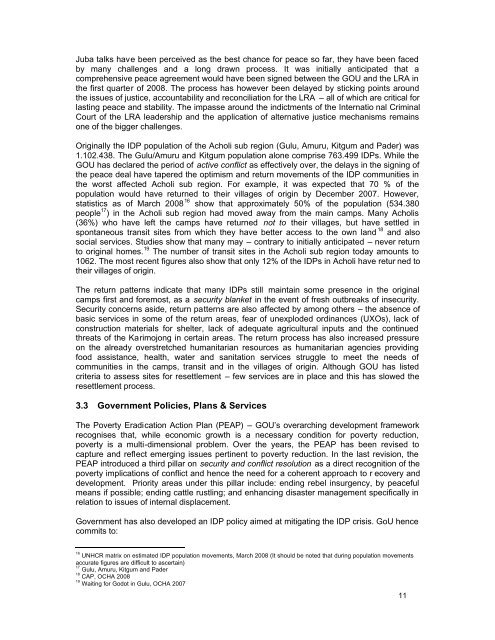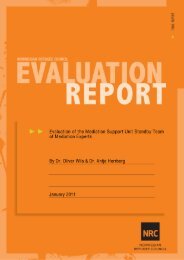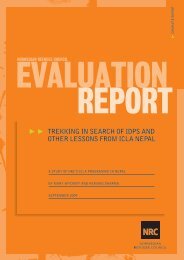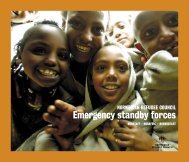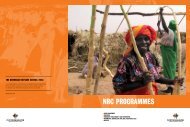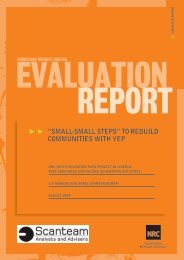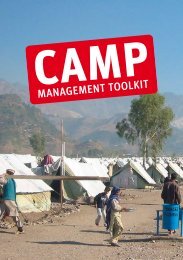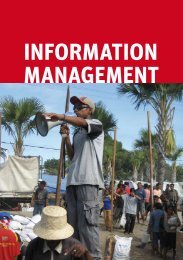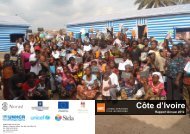evaluation of general food distribution in northern uganda: gulu ...
evaluation of general food distribution in northern uganda: gulu ...
evaluation of general food distribution in northern uganda: gulu ...
Create successful ePaper yourself
Turn your PDF publications into a flip-book with our unique Google optimized e-Paper software.
Juba talks have been perceived as the best chance for peace so far, they have been facedby many challenges and a long drawn process. It was <strong>in</strong>itially anticipated that acomprehensive peace agreement would have been signed between the GOU and the LRA <strong>in</strong>the first quarter <strong>of</strong> 2008. The process has however been delayed by stick<strong>in</strong>g po<strong>in</strong>ts aroundthe issues <strong>of</strong> justice, accountability and reconciliation for the LRA – all <strong>of</strong> which are critical forlast<strong>in</strong>g peace and stability. The impasse around the <strong>in</strong>dictments <strong>of</strong> the Internatio nal Crim<strong>in</strong>alCourt <strong>of</strong> the LRA leadership and the application <strong>of</strong> alternative justice mechanisms rema<strong>in</strong>sone <strong>of</strong> the bigger challenges.Orig<strong>in</strong>ally the IDP population <strong>of</strong> the Acholi sub region (Gulu, Amuru, Kitgum and Pader) was1.102.438. The Gulu/Amuru and Kitgum population alone comprise 763.499 IDPs. While theGOU has declared the period <strong>of</strong> active conflict as effectively over, the delays <strong>in</strong> the sign<strong>in</strong>g <strong>of</strong>the peace deal have tapered the optimism and return movements <strong>of</strong> the IDP communities <strong>in</strong>the worst affected Acholi sub region. For example, it was expected that 70 % <strong>of</strong> thepopulation would have returned to their villages <strong>of</strong> orig<strong>in</strong> by December 2007. However,statistics as <strong>of</strong> March 2008 16 show that approximately 50% <strong>of</strong> the population (534.380people 17 ) <strong>in</strong> the Acholi sub region had moved away from the ma<strong>in</strong> camps. Many Acholis(36%) who have left the camps have returned not to their villages, but have settled <strong>in</strong>spontaneous transit sites from which they have better access to the own land 18 and alsosocial services. Studies show that many may – contrary to <strong>in</strong>itially anticipated – never returnto orig<strong>in</strong>al homes. 19 The number <strong>of</strong> transit sites <strong>in</strong> the Acholi sub region today amounts to1062. The most recent figures also show that only 12% <strong>of</strong> the IDPs <strong>in</strong> Acholi have retur ned totheir villages <strong>of</strong> orig<strong>in</strong>.The return patterns <strong>in</strong>dicate that many IDPs still ma<strong>in</strong>ta<strong>in</strong> some presence <strong>in</strong> the orig<strong>in</strong>alcamps first and foremost, as a security blanket <strong>in</strong> the event <strong>of</strong> fresh outbreaks <strong>of</strong> <strong>in</strong>security.Security concerns aside, return patterns are also affected by among others – the absence <strong>of</strong>basic services <strong>in</strong> some <strong>of</strong> the return areas, fear <strong>of</strong> unexploded ord<strong>in</strong>ances (UXOs), lack <strong>of</strong>construction materials for shelter, lack <strong>of</strong> adequate agricultural <strong>in</strong>puts and the cont<strong>in</strong>uedthreats <strong>of</strong> the Karimojong <strong>in</strong> certa<strong>in</strong> areas. The return process has also <strong>in</strong>creased pressureon the already overstretched humanitarian resources as humanitarian agencies provid<strong>in</strong>g<strong>food</strong> assistance, health, water and sanitation services struggle to meet the needs <strong>of</strong>communities <strong>in</strong> the camps, transit and <strong>in</strong> the villages <strong>of</strong> orig<strong>in</strong>. Although GOU has listedcriteria to assess sites for resettlement – few services are <strong>in</strong> place and this has slowed theresettlement process.3.3 Government Policies, Plans & ServicesThe Poverty Eradication Action Plan (PEAP) – GOU’s overarch<strong>in</strong>g development frameworkrecognises that, while economic growth is a necessary condition for poverty reduction,poverty is a multi-dimensional problem. Over the years, the PEAP has been revised tocapture and reflect emerg<strong>in</strong>g issues pert<strong>in</strong>ent to poverty reduction. In the last revision, thePEAP <strong>in</strong>troduced a third pillar on security and conflict resolution as a direct recognition <strong>of</strong> thepoverty implications <strong>of</strong> conflict and hence the need for a coherent approach to r ecovery anddevelopment. Priority areas under this pillar <strong>in</strong>clude: end<strong>in</strong>g rebel <strong>in</strong>surgency, by peacefulmeans if possible; end<strong>in</strong>g cattle rustl<strong>in</strong>g; and enhanc<strong>in</strong>g disaster management specifically <strong>in</strong>relation to issues <strong>of</strong> <strong>in</strong>ternal displacement.Government has also developed an IDP policy aimed at mitigat<strong>in</strong>g the IDP crisis. GoU hencecommits to:16UNHCR matrix on estimated IDP population movements, March 2008 (It should be noted that dur<strong>in</strong>g population movementsaccurate figures are difficult to ascerta<strong>in</strong>)17Gulu, Amuru, Kitgum and Pader18CAP, OCHA 200819Wait<strong>in</strong>g for Godot <strong>in</strong> Gulu, OCHA 200711


